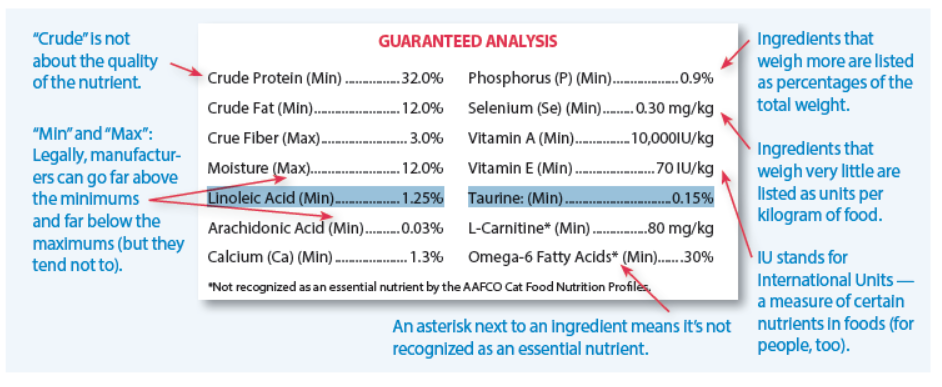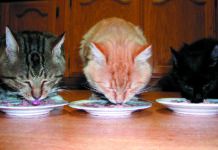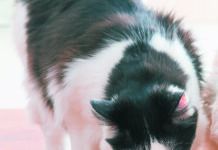Every cat food label contains a Guaranteed Analysis, a series of nutrient values listed as percentages or “milligrams per kilogram” with no instructions explaining their significance in a cat’s diet. Adding to the confusion is that every single number is listed as a “minimum”or “maximum,” and you can’t figure out whether you’re getting the least or the most allowed of any particular nutrient. The reason the numbers are so arcane is that they’re based on nutrition labels for food fed to animals like cattle and chicken, which then get turned into food for people. “When pet foods became common, the template just got moved over from livestock and never really got adjusted,” says board-certified veterinary nutritionist Cailin Heinze, VMD. “It’s a lot different from what we are used to seeing on “Nutrition Facts” labels for human foods.” To clear up some of the confusion, here’s a Guaranteed Analysis primer.
Minimums and maximums
The nutrient values in the Guaranteed Analyses are minimums and maximums, not specific values. It means that it would be illegal for the manufacturer to provide less or more than that percentage but otherwise provides lots of potential for variability. Note: only two ingredients have maximums: fiber and water.
Percentage or actual amount?
The reason some nutrients are given as percentages and others as milligrams per kilogram presumably goes back to how much the nutrient actually weighs. Consider that protein and fat are macronutrients and are therefore bigger and heavier than micro-nutrients like minerals. Thus, it’s easier to list them as percentages of the total weight of the food. (The percentage is literally the number of grams of the nutrient per 100 grams of the food.) Minerals such as zinc and selenium, on the other hand, weigh so little that the percentage of each would be only a fraction of 1 percent. It would be hard to provide accurate amounts in percentages without using a lot of decimal places. That’s why minerals and other nutrients are given as milligrams (or sometimes International Units — a nutritional measure of certain vitamins per kilogram of food).
Crudely speaking
Three nutrients on the Guaranteed Analysis are listed as “crude”: crude protein, crude fat, and crude fiber. It doesn’t mean “crude” as in low quality. It just indicates how the measurements are calculated. Take protein, for instance. It’s not measured directly in pet food. Instead, the manufacturer measures the total amount of nitrogen — a component of protein. From there the manufacturer makes some conversions, dividing units of nitrogen by units of nitrogen in specific proteins, to arrive at the number. It’s done in such a roundabout, “crude” way because calculating the amount of protein directly is a lot more complicated and expensive. (Protein in people food is measured the same way.)
Why some numbers have asterisks
Only fat, protein, moisture, and fiber are required to be listed on a Guaranteed Analysis. However, manufacturers frequently list other nutrients to call attention to them. Occasionally, nutrients are added for which cats do not have a specific published requirement. A nutrient in the Guaranteed Analysis with an asterisk next to it means the substance is not considered an essential nutrient by the Association of American Feed Control Officials (AAFCO), the body that oversees standards for cat foods. As an example, ascorbic acid, commonly known as vitamin C, is sometimes put into cat food as an antioxidant or preservative, even though cats can make their own vitamin C. Therefore, it is not an essential nutrient.
How the Guaranteed Analysis doesn’t “add up”
Now that you understand everything in the Guaranteed Analysis, you might assume you can use the information to make a good food choice for your cat. You can’t. Take a comparison of dry kibble to canned food. Off the bat, it looks like the canned food is significantly lower in protein, fat, fiber, calcium, and phosphorus than dry. But that’s just because the largest percentage in canned food is always going be water. Indeed, canned food averages about 75 percent moisture by weight, and sometimes as much as 85 percent. That pushes down all the other percentages significantly. It has nothing to do with the actual amount of other nutrients in the food. Canned food has as much of those nutrients as dry. It’s just diluted by water. Making a true comparison would require a calculator, a short course in wet-to-dry comparisons, and several calculations. “Even comparing dry to dry doesn’t give a helpful comparison unless the calories in the two foods are pretty similar,” Dr. Heinze says. For example, if a lower-calorie food has a lower percentage protein for its weight than a higher-calorie food, a cat may still end up consuming the same amount of protein with the lower-calorie food because he will be taking in more of that food to meet his calorie needs. Given the gap between the numbers in a Guaranteed Analysis and the information people can actually glean from the numbers, veterinary nutritionists like Dr. Heinze are hoping that AAFCO will develop a label that more closely resembles the Nutrition Facts labels on foods for people, which has more value as a guide to making healthful food choices. 





i WISH YOU WOULD MENTION THE BEST BRANDS, OUR WIDGIT LOVES FANCY FEAST TUSCANY, PRIMAVERA, MEDITERREAN WITH VEGETABLES, SHE ALSO LOVES FRESH BABY KALE.
SHE WAS ABANDONED HERE IN AN APARTMENT AT ABOUT 5 OR 6 MONTHS OLD ACCORDING TO THE VET.
SHE’S NOT A CUDDLY CAT BUT IS GETTING BETTER AT BEING HELD AND CUDDLED NOW SHE’S 5 YEARS.
Would also like an indication ofCatnip’s Tips on best wet and dry for cats.
I already have purchased the Catnip newsletter, but you still won’t let me read the digital form. Why?